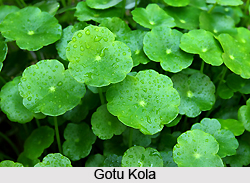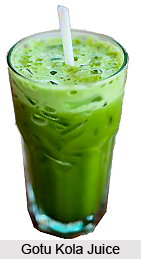 Gotu kola is a small, herbaceous, annual plant of the family Mackinlayaceae. The biological name of Gotu kola is Centella asiatica. This plant grows in a widespread distribution in tropical, swampy areas, including parts of India, Pakistan, Sri Lanka, Madagascar, and South Africa. It also grows in Eastern Europe. The roots and leaves are used medicinally. It is used in Ayurvedic medicine, traditional African medicine, and traditional Chinese medicine.
Gotu kola is a small, herbaceous, annual plant of the family Mackinlayaceae. The biological name of Gotu kola is Centella asiatica. This plant grows in a widespread distribution in tropical, swampy areas, including parts of India, Pakistan, Sri Lanka, Madagascar, and South Africa. It also grows in Eastern Europe. The roots and leaves are used medicinally. It is used in Ayurvedic medicine, traditional African medicine, and traditional Chinese medicine.
Description of Gotu Kola
The stems of Gotu kola are slender, green to reddish-green in colour, connecting plants to each other. It comprises of long-stalked, green, rounded apices. The leaves are borne on pericladial petioles and the rootstock consists of rhizomes, growing vertically down. The flowers born in small, rounded bunch near the surface of the soil. They are white or pinkish to red in colour. The fruits are densely reticulate.
Active Constituents of Gotu Kola
The primary active constituents of Gotu kola are saponins, which include asiaticoside, madecassoside and madasiatic acid. These saponins may prevent excessive scar formation by inhibiting the production of collagen (the material that makes up connective tissue) at the wound site. These constituents are also associated with promoting wound healing. One preliminary trial in humans found that a Gotu kola extract improved healing of infected wounds (unless the infection had reached bone).
 Medicinal Uses of Gotu Kola
Medicinal Uses of Gotu Kola
Gotu kola has been important in the medicinal systems of central Asia for centuries. In Sri Lanka, it was purported to prolong life, as elephants commonly eat the leaves. Numerous skin diseases, ranging from poorly healing wounds to leprosy, have been treated with Gotu kola. Gotu kola also has a historical reputation for boosting mental activity and for helping a variety of illnesses, such as high blood pressure, rheumatism, fever, and nervous disorders. Some of its common applications in Ayurvedic medicine include heart disease, water retention, hoarseness, bronchitis, and coughs in children, and as a poultice for many skin conditions. Gotu kola can also improve healing of burns. Gotu kola extracts are helpful for preventing and treating enlarged scars (keloids).
Culinary Use of Gotu Kola
Gotu kola is used as a leafy green in Sri Lankan cuisine. The herb is mostly prepared as malluma, a traditional accompaniment to rice and curry. It is usually paired up with vegetarian dishes like dhal, and jackfruit or pumpkin curry. The preparation is considered very filling and healthy.
Side Effects of Gotu Kola
Except for the rare person who is allergic to gotu kola, no significant adverse effects are experienced with internal or topical use of this herb. At the time of writing, there were no well-known drug interactions with Gotu kola.



















